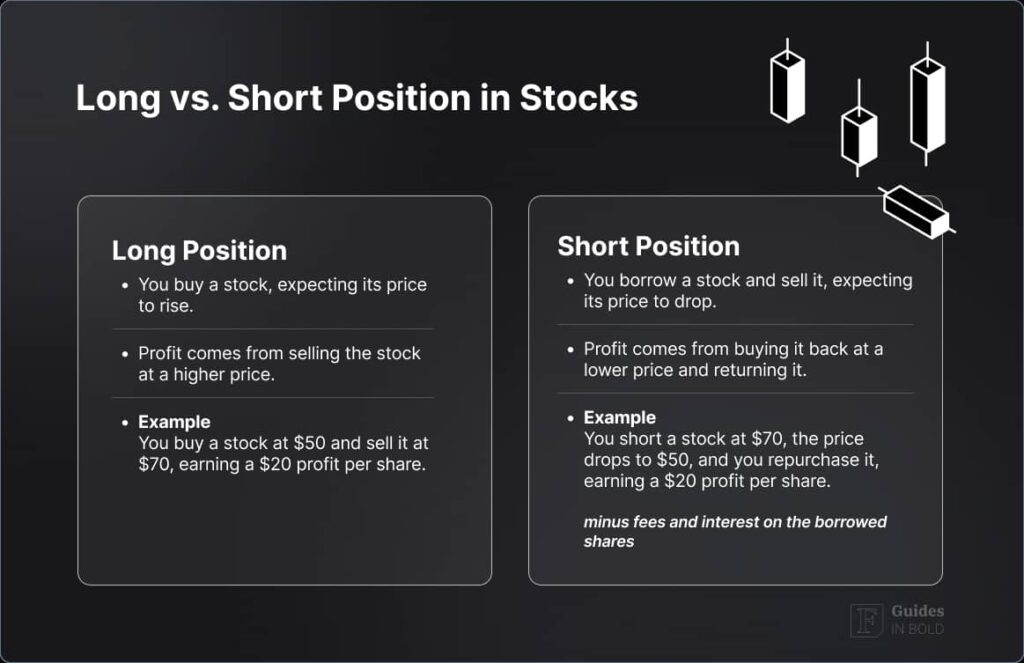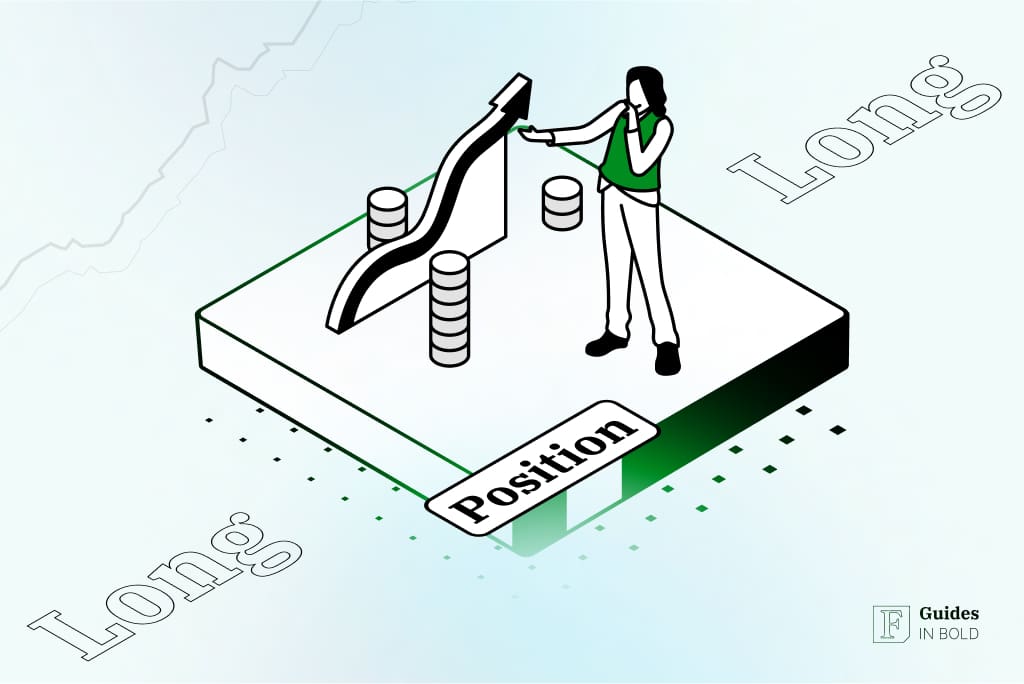This post will examine going long or long positions in stocks, what it means in investing, as well as options and futures trading.
Highly Rated Stock Trading & Investing Platform
-
Invest in stocks, ETFs, options and crypto
-
Copy top-performing crypto-traders in real time, automatically.
-
0% commission on buying stocks - buy in bulk or just a fraction from as little as $10. Other fees apply. For more information, visit etoro.com/trading/fees.
-
eToro USA is registered with FINRA for securities trading.
A long position in investing
A long position in stocks is a preferred strategy for most individual investors. Indeed, it takes less effort to manage once you have chosen and purchased the stock.
Long position vs short position in stocks

Beginners’ corner:
- What is Investing? Putting Money to Work
- 17 Common Investing Mistakes to Avoid
- 15 Top-Rated Investment Books of All Time
- How to Buy Stocks? Complete Beginner’s Guide
- 10 Best Stock Trading Books for Beginners
- 6 Basic Rules of Investing
- Dividend Investing for Beginners
- 5 Passive Income Investment Ideas
Pros and cons of a taking long position in stocks

Pros
- Historically, the stock market and share prices have gone up over the long term. So, on average, taking long positions, i.e., holding your assets, makes money. Indeed, a passive investing approach constantly outperforms more active investing methods over the long run;
- To anticipate price appreciation in the long term spares the investor the need for constant market-watching or market-timing;
- Going long tends to be a lower risk than other strategies. A long-term timeframe allows time to weather the inevitable ups and downs;
- If you purchase and hold a security for at least one year, the taxes you owe on any gains when you sell are lower.

Cons
- Your capital is tied up, likely for years, which can result in missing out on other opportunities;
- The longer you hold, the more susceptible you are to an unfavorable event, e.g., the company going bankrupt;
- Possible big drops in value if a bear market is looming at your desired time to sell or retire.
Highly Rated Stock Trading & Investing Platform
-
Invest in stocks, ETFs, options and crypto
-
Copy top-performing crypto-traders in real time, automatically.
-
0% commission on buying stocks - buy in bulk or just a fraction from as little as $10. Other fees apply. For more information, visit etoro.com/trading/fees.
-
eToro USA is registered with FINRA for securities trading.
A long position in options trading
Options are a contract giving you the right, but not the obligation, to buy (call) or sell (put) a security at a fixed price before a predetermined date. Long positions in options trading can be divided into long calls or long puts.
- A long call option grants the buyer the right to buy shares of a stock at a preset (today’s) price in the future and profit by selling it on the stock market at the then-higher price. The investor believes the price will go up in the future, expressing a bullish sentiment on the underlying stock;
- A long put option grants the buyer the right to sell shares of stock at a preset price in the future. The holder of a long put option assumes the price of an asset will fall, and purchasing a long put option contract gives them the right to sell shares of that stock in the future for today’s (higher) price. A long put option expresses a bearish sentiment on the underlying stock.
Long call options are more common, while long put options are often used in tandem with a long position as a hedge. In short, the long position holder owns the underlying asset and hopes the price will appreciate, but if it doesn’t, the long put acts as insurance coverage, offering a chance to sell in case of a price slump.

Long call option example
You predict stock X, selling today for $100 a share, will be worth more in a few months. So you purchase a long call option contract (100 shares), set to expire in three months, at a strike (preset) price of $100 per share and a premium of $2 per share for the option itself. Stock X does as you predicted, and shares are worth $150 a piece in two months. So if you exercise your option, buy 100 shares at $100 each, and sell them for $150 each, you make a profit of $4,800 ($15,000-$10,000-$200).
Long put option example
Conversely, if you believe stock X will decline in a couple of months. Then, you purchase a long put option contract, also set to expire in three months, at a strike price of $100 and a premium of $2 per share. Stock X does as you expected, and in two months, shares are selling for $50. So you buy 100 shares at $50 each, exercise your option, and sell them for $100 each, making a solid gain of $4,800.
A long position in futures contracts
A futures contract is a derivative contract that obligates the holder to buy or sell a particular stock, commodity, or financial instrument at a set price at a predetermined date.
Investors and businesses (called hedgers in futures trading) can enter into a futures contract to hedge against adverse price movements. An investor expects to profit from a rise in the underlying security price (long position) by purchasing the right to buy. For example, a company can employ a long hedge to lock in a purchase price today to lessen market volatility between now and when goods are delivered or received.
Speculators also go long on futures contracts when they believe the asset’s value will increase to capitalize on the price movement.
Futures long position example (hedging strategy)
Let’s imagine a jewelry manufacturer that anticipates the price of silver to increase in the short term. As a result, the establishment enters into a long futures contract with its supplier to purchase silver in two months at $700. In two months, whether the price is above or below $700, the company with a long position on silver futures is obligated to purchase the silver from the supplier at the predetermined contract price of $700. The supplier, in turn, is bound to deliver the physical commodity when the contract expires.
In conclusion
To sum up, all types of long positions in stocks are bullish strategies because you are purchasing a stock that you predict will increase in value. The bottom line is that you think your investment, be it the underlying stock, stock option, or futures contracts, will, in time, prove to be a gainer.
Disclaimer: The content on this site should not be considered investment advice. Investing is speculative. When investing, your capital is at risk.
FAQs about long positions
What is a long position in stocks?
A long position in stocks refers to the purchase of a stock with the expectation that its value will rise over time. When an investor takes a long position, they buy the stock intending to sell it later at a higher price, aiming to make a profit from the increase in value.
What is the difference between a long vs short position?
A long position in stocks is when an investor buys shares with the expectation that their price will rise, aiming to sell them later at a higher price for profit. In contrast, a short position involves borrowing and selling shares with the anticipation that their price will fall, intending to buy them back at a lower price to return them, thus profiting from the difference. Essentially, long positions bet on a stock’s price increase, while short positions bet on its decrease.
How to hedge a long stock position?
To hedge a long stock position, investors commonly buy put options, allowing them to sell the stock at a predetermined price, limiting losses if the stock’s value falls. Other methods include short selling a related stock or index to offset losses, or setting stop-loss orders to automatically sell the stock if it drops to a certain price, thereby capping potential losses.
What is a synthetic long position?
A synthetic long position is created by simultaneously buying a call option and selling a put option on the same stock, with identical strike prices and expiration dates. This strategy mimics the financial outcome of owning the actual stock, leveraging potential gains from the stock’s price increase without the need to invest in the stock directly.
What is a long position in a call?
A long position in a call option is when an investor purchases a call option, betting that the underlying asset’s price will rise above the strike price before the option expires, aiming to profit from this increase.
What's a long put position?
A long put position is when an investor buys a put option, betting that the underlying asset’s price will fall below the strike price before the option expires, aiming to profit from this decrease.
How long can you hold a long position?
You can hold a long position indefinitely, as long as you choose to or until you decide to sell the asset.
Highly Rated Stock Trading & Investing Platform
-
Invest in stocks, ETFs, options and crypto
-
Copy top-performing crypto-traders in real time, automatically.
-
0% commission on buying stocks - buy in bulk or just a fraction from as little as $10. Other fees apply. For more information, visit etoro.com/trading/fees.
-
eToro USA is registered with FINRA for securities trading.





